From Matt's Book "I Married a Lesbian or In Search of Sardeles Pastes"
|
|
According to
Andrea and Let's Go Greece, This is the second
most holy place in Greece, (next to the church
in Tinos where people crawl on their hands and
knees up the steps to the holy icon of the
Panagia). On the first of August the pilgrims
begin to arrive here, camping on the road that
leads to the large church in the center of
town. By the fifteenth of the month, the
Holy-day of the Virgin Mary, the place is a
madhouse. Today is only the sixth and driving
through the tiny steeply-inclined streets,
already full of people, is horrifying. The
first miracle of the season is that I don't
run over anyone. The roads are narrow and at
such a sharp incline that I have to keep a
delicate balance bewteen the brake and the gas
since I must stop frequently for pedestrians.
We park the car at the top of the village
where Andrea's cousins Sophia and Anna live
with their Grandmother Sophia. They are
ecstatic to see us and especially happy to see
Amarandi with whom they play for hours until
they become exhausted and leave her with us.
We have a wonderful lunch of the largest pink
snapper I had ever seen.
|
|
Andrea's cousin Yacovah is the Bishop of
Mytilini and he is in town for the
festivities. This spring he had gone to Serbia
and brought fifty children here to escape the
war for six months. They became very attached
to the village and the villagers to them, and
did not want to go back to their war torn
country. The final evening together everybody
was crying knowing that they were returning to
a tragedy. What a sad moment it must have been
when they all left and the villagers realized
that these innocent children were going back
to the war. Soon some of them would be
fighting. Others would lose parents, brothers
and sisters or become victims
themselves.
"War is
a catastrophe," grandmother Sophia says
"Nobody ever really wins."
|
|
Andrea and I put
Amarandi in her stroller and walk down the
cobblestone streets to the main square of the
village. Amarandi is asleep within five
minutes and misses out on all the
entertainment. This is the second to last
Sunday before the panagiri, whatever
significance that has, and the town is
jumping. The cafeneons are crammed full of old
men. Around the church are numerous shops and
stalls selling everything from religious icons
to ouzo and sardines. Inside the church
complex are dozens of old women who walk up
and kiss the hand of Andrea's cousin the
bishop and the holy miracle working icon,
which has seen better days and is nearly
unrecognizable. There is also the skull of a
Saint Theodore who was massacred by the Turks
two hundred years ago and is now getting his
share of kisses by the old ladies and
pilgrims. Even Andrea gives him a little peck
on the forehead. There seem to be a few ladies
around who I might describe as hookers, maybe
seeking redemption or perhaps easy prey. We
wander around the courtyard of the large
church where people are camped out in homemade
tents that look quite luxurious and inviting.
There is also a hostel where people can stay,
with balconies full of old women calling out
to their friends and neigbors. The streets
outside the church are packed. There are more
stores, selling ceramics, plastic toys, and
everything else you can imagine. We stop and
sit in the small shop of Yannis Kamouris,
Greece's most renown santouri player who
serenades us with several different styles of
music. We buy a tape from him and continue
walking to the bottom of the hill where
pilgrims are arriving by the busload.
|
|
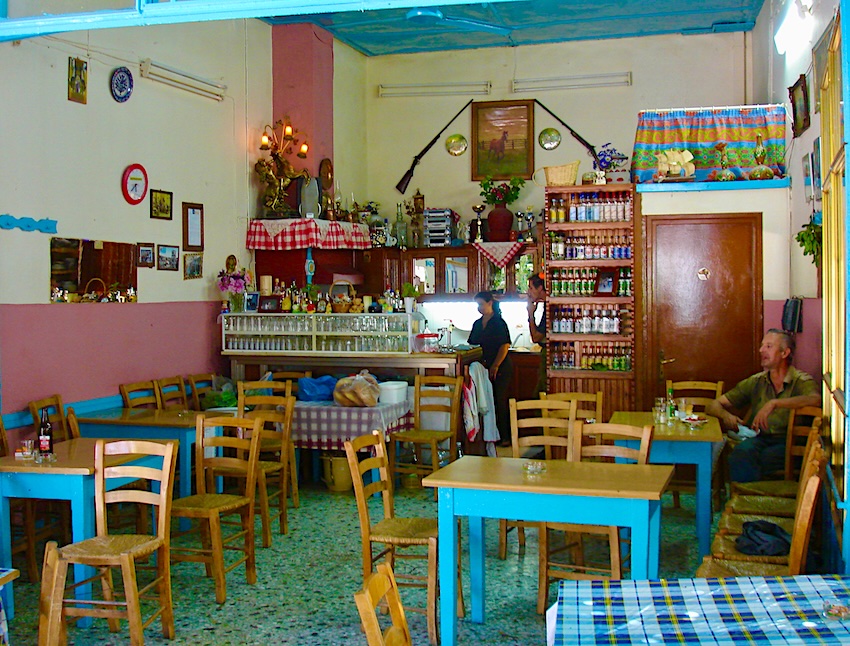
We turn around and
start up the hill ready to begin the night of
ouzo and entertainment. We walk past the
tourist restaurants that advertise their fare
in big English letters, to the settlement of
cafeneons around the famous church. We find
the least crowded and take a seat on the
street. I order some fried sardines and some
ouzo and we begin the night's festivities. It
is as traditional a place as you could
imagine. No menu. Just Ouzo, beer, restsina
and whatever the proprietor happens to be
making to eat that evening. While we are going
through our first bottle of ouzo I see a
retarded fellow drop a pile of fish on the
next table. I follow him down the hill to see
what the deal is. He goes into a store where a
man is selling raw
sardines. 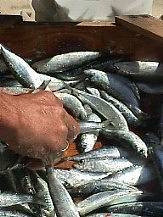 They were caught this morning in the bay of
Kaloni and then left in salt for several
hours. I buy a handful for two hundred drachs
and bring them back to Andrea to her
un-delight. These are the famous sardeles
pastes. I eat the first one, skin bones and
all and realize I either have a lot to learn
about sardeles pastes, or that I better find
some hungry cats. I don't panic though. I walk
over to the next table to see what the pros
are doing with theirs since they obviously
know a little more then I do. A man leaps up
from another table and comes to our rescue,
not only showing me how to clean them, by
removing the skin and the heads, but cleaning
my entire bag full. I thank him and try the
first one. Delicious. Better than sushi and
perfect with ouzo. Before I know it they are
all gone and I'm drunk on ouzo and raw fish. I
stumble back to the store where I had
gotten them but the retarded guy and his boss
have disappeared into the night. When I return
to Andrea we are given a plate of stewed crab
by the old men at the next table. I return the
favor, buying them a bottle of ouzo. By the
time we leave we were all good friends.
They were caught this morning in the bay of
Kaloni and then left in salt for several
hours. I buy a handful for two hundred drachs
and bring them back to Andrea to her
un-delight. These are the famous sardeles
pastes. I eat the first one, skin bones and
all and realize I either have a lot to learn
about sardeles pastes, or that I better find
some hungry cats. I don't panic though. I walk
over to the next table to see what the pros
are doing with theirs since they obviously
know a little more then I do. A man leaps up
from another table and comes to our rescue,
not only showing me how to clean them, by
removing the skin and the heads, but cleaning
my entire bag full. I thank him and try the
first one. Delicious. Better than sushi and
perfect with ouzo. Before I know it they are
all gone and I'm drunk on ouzo and raw fish. I
stumble back to the store where I had
gotten them but the retarded guy and his boss
have disappeared into the night. When I return
to Andrea we are given a plate of stewed crab
by the old men at the next table. I return the
favor, buying them a bottle of ouzo. By the
time we leave we were all good friends.
|
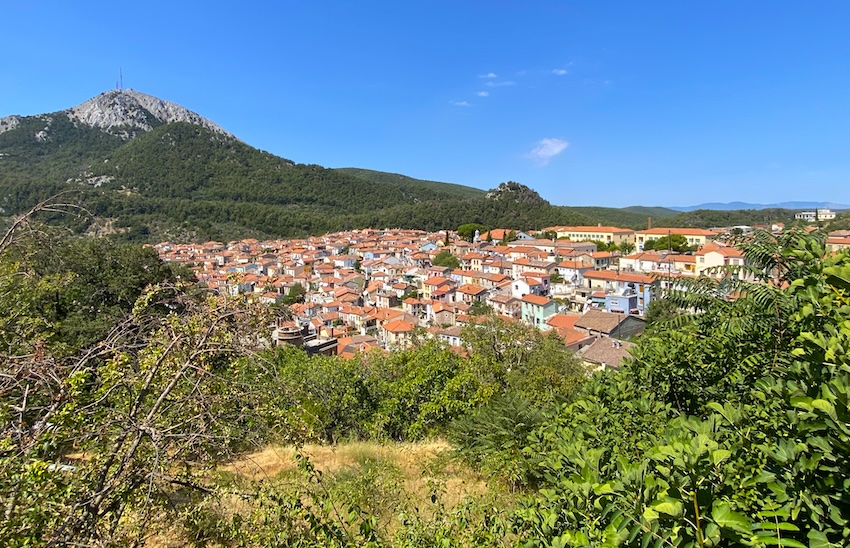 |
|
Tuesday
August 8th
I'm sitting in the highest cafeneon in the
village of Agiassou under five large pine
trees that Andrea's grandfather planted fifty
years ago. This used to be his field but they
built a road through it and split a small part
off. He made that part the cafeneon and the
other side he built three houses for his
daughters. The cafeneon is built where the
road makes a hairpin turn up the mountain. On
one side it is at street level. The other side
is a drop of fifty feet and a steeply inclined
staircase. The patio is about thirty yards
long, covered by a grape arbor. It overlooks a
part of the village and most of the valley
between here and the Sea of Yeros(above
right). Because we are so high in the
mountains the morning temperature is much
cooler then below. It feels like the most
beautiful North Carolina spring day.
Agiasou is my new
favorite village in Greece. It's more of a
city really, built between the peaks of two
mountains and rising up the sides of both. The
architecture is completely traditional. It's
difficult to find any building in bad taste.
The approach to the town is lined with
restaurants for the pilgrims coming for the
celebration of the Virgin Mary at the large
church that holds the central position in the
village. Around it are the cafeneons and that
is where the real life is. Always full of men
and friendly conversation they serve a
collection of interesting snacks to go with
the local ouzo that everybody drinks. Everyone
is very friendly because they have not been
besieged by the Euro-tourists whose paradise
is the beaches and resorts that dot the rocky
coast.
For me Agiassou is a revelation. Life on
Lesvos is in the mountain villages. While
towns like Erressos and Molivos rake in the
pounds, marks and dollars, destroying
tradition in the process, the mountain
villages have thrived in a sensible way and
have retained the charm and lifestyle that
they have had for hundreds of years, or
more.
Andrea's aunt Sophia's house is at the top of
the village. Beyond it is a famous old
sanitarium on the old dirt road to Plomari,
impassable in anything but a four-wheel-drive
vehicle or a rental car. The cafeneons are at
the center of the village halfway down. It's
an enjoyable trip getting there but coming
back is hell, especially with a belly full of
raw sardines, a head full of ouzo and pushing
a baby stroller with a child who grows heavier
with each step.
|
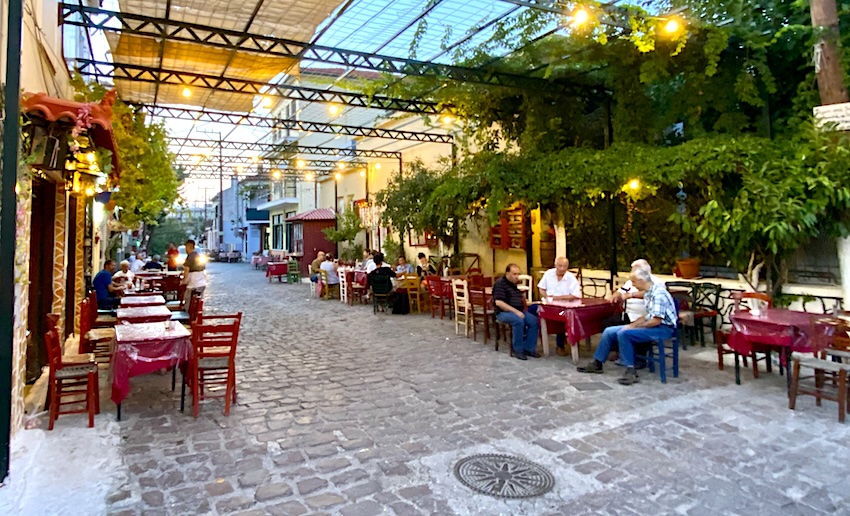 |
|
Last night Andrea
introduced me to the cafeneons of the upper
village and what I saw as the only
imperfection of life here has been eliminated.
It made sense to me that not everybody would
want to walk up and down a mountain everytime
they wanted a drink. These four old cafeneons
addressed that problem. The food was just as
delicious and the people as friendly as below.
They are just less labor intensive. Last night
for the first time I had Kolios Pastes which
is raw mackerel rather then sardines. It was
delicious. I could have eaten two or three
orders but Aunt Sophia was making a feast for
us back at the house so we had to control
ourselves. Amarandi was also being impossible
and we only shared one bottle of ouzo before
walking back to the house where we ate stuffed
eggplant, fried squid, tomato salad and home
made feta cheese.
After dinner we watched a little television.
Mega-Channel was showing "The Two Jakes", but
it started at 11:45. The problem with watching
movies on TV in Greece at night is that no
matter what is going on in the film, at
precisely twelve midnight they cut to a half
hour of news. Every channel does this. I
suppose it's to have a captive audience. It's
more like a hostage situation. Then after the
weather report (which is always the same,
sunny and hot,) back comes the film, sometimes
in mid-sentence or action. Except by then
usually I'm not interested anymore and after
about five minutes of trying to remember the
plot I give up and go to bed.
We
make an incredible discovery today. We don't
have to drive down the hill through the
village, or up for that matter. It had been my
own special hell negotiating the narrow
streets full of tourists and pilgrims, that
are at such an incline that one faulty foot
movement could cause the car to stall.
Re-starting requires deft hand and foot
coordination between the brake pedal, the
clutch, the gas and the hand brake. Now we
have found the secret back entrance to the
village that goes past the football stadium
and what might be called the industrial zone.
It connects with the main road outside the
village. We had seen the road before but
assumed it went to some monastery. Now we can
come and go without the accompanying
terror.
|
|
I
love Andrea's cousins Anna and Sophia. Their
mother died ten tears ago. Their father is in
the merchant marines and travels continuously
so they have been left with their grandmother
Sophia who is very religious. The two girls
are not what you would call "wild" but they
are hip and know what is going on. Sophia is
nineteen and lives in Athens. Anna is around
seventeen and still lives here in Agiassos.
They tell me a saying that the men in Mytilini
have.
"From Agiasou or
Plomari
neither woman
nor mulari*"
*mule
They
think it's funny because their mother is from
Agiassos and their father is from Plomari.
Sophia has made a pact with the Virgin Mary to
wear black for fifteen days every year. In
return the virgin will help her pass her
exams. I ask her if I wore black would the
Virgin go to work for me so I can stay home
and read. They think it's a funny idea. I'm
glad they aren't offended. They are both
beautiful and they speak English in the most
endearing style possible. |
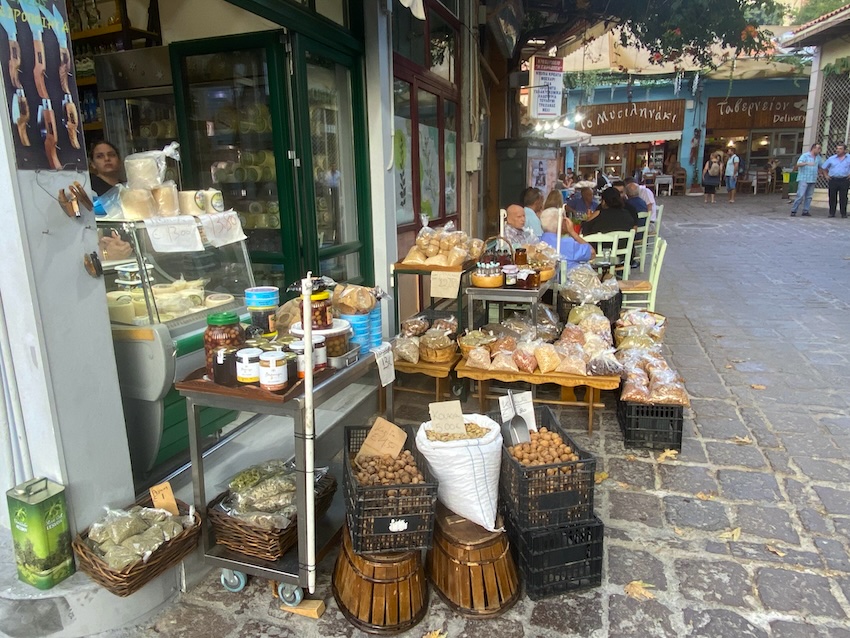 |
|
Tonight they go to
the church. Andrea arranges to meet them after
the ceremony and while she and Amarandi watch
the service I wander around the market place
surrounding the church. I pass the shops which
sell religious products like icons, statues
and talismans and stop at a market and begin
looking at different brands of ouzo and canned
fish. According to the store owner all the
ouzo is good. It just depends on your taste.
But the ouzo from Plomari is much stronger.
That would explain why they say all the people
from there are crazy. I feel a certain madness
has set in in my own consciousness, or semi
consciousness, and I've been drinking the
regular Mytilini stuff. Following the man's
advice I buy three bottles of
ouzo
Veto which
seems to be the favorite of many people,
Andrea and her uncle Panayotis included. I
also buy several tins of sardines, mackerel,
and anchovies,
in the blue
cans, as I
was told to by Andrea's aunt in Xidera.
We walk back up the
mountain with Andrea pushing Amarandi in the
stroller and me carrying twenty pounds of ouzo
and canned fish. We go back to the cafeneons
in the upper village and sit where we had
eaten last night. Tonight they are featuring
sardeles pastes, just like I had eaten
with Andrea's uncle Panayotis at lunch.
We also have the best fried potatoes of the
summer, even better then Thea Katina's and the
worlds best fried squid. We drink two bottles
of ouzo while Amarandi plays with the local
cats and Andrea tells me the story of how she
first came to Xidera as a teenager in the
nineteen-sixties. To her it was like being
sentenced to a term in Siberia and she and her
cousin sat in the room they had been given,
listening to tapes of the Rolling Stones and
corrupting her three year old cousin.
|
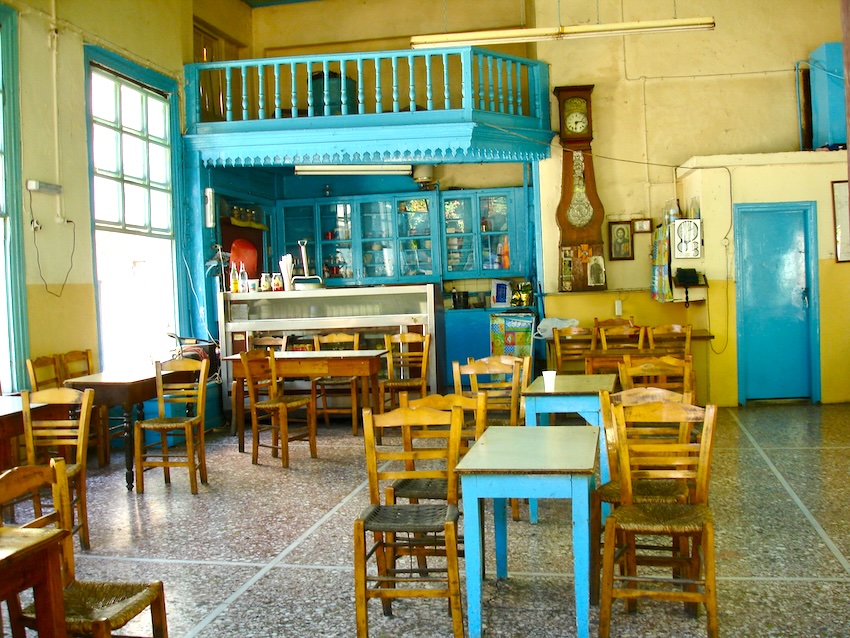 |
|
The cafeneon owner
is a great host and each dish is better then
the last. The people of Mytilini have
perfected the art of drinking and eating. If
someone gave me a plate of sardines, pastes
style, I would probably throw-up. Yet when
served with ouzo they are perfect. Sometimes I
think about them when I am driving or laying
in bed. They are the Greek equivalent of Sushi
and either you love them or hate them. They're
considered something special here. None of the
cafeneons serve them every night. It's a
matter of luck if the place you sit down in
offers them. To go from cafe to cafe asking if
they have them is in bad taste as I realized
when I did it tonight at the cafeneons down
below. The old men are probably still talking
about me.
We
pay and leave. Of course it was amazingly
cheap. The good thing is we don't have to walk
all the way up the mountain which we would
have had to if we had eaten below. We also
discover that the delicious mackerel we had
eaten there last night were the same ones they
sell in the can. The blue can of
course.
So
just as I started the day in the cafeneon that
Andrea's grandfather built, high in the upper
village, I now end it. The wind is blowing and
I can't remember ever feeling a climate more
comfortable. My only complaint is about the
Agiassos teenagers riding by on their super
loud motorbikes, doing wheelies down the hill
to impress the girls hanging out here who are
not the least bit interested.
|
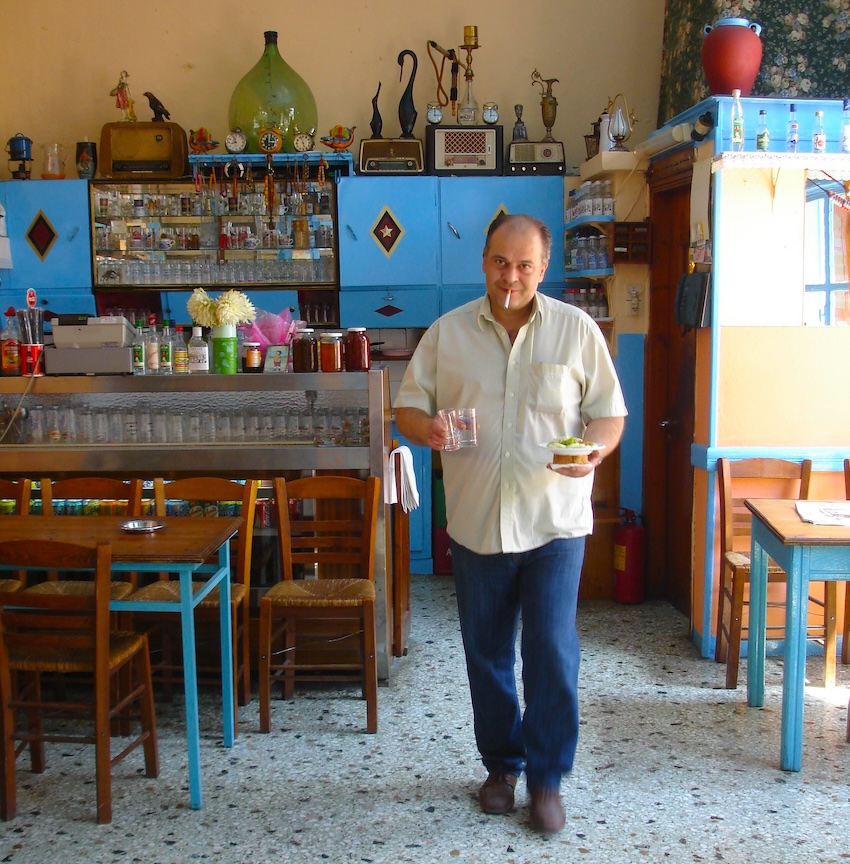 |
|
August 8th
I
wake up to the sound of the dekaoctades. These
are doves who chant the number eighteen,
deka-octo, thus the name. I don't know if
everybody calls them that, but Andrea does.
It's very early when I go outside and walk
next door to the little church that Aunt
Sophia takes care of. I know it's her because
like her own roof and terraces, every
available inch of space is covered with well
cared for potted plants. Inside are several
nice icons, behind glass, even though they're
quite modern.
I
come over to the Famaka, which is the name of
the cafeneon across the street that Andrea's
grandfather built. It used to be called the
Casino until a girl moved here from another
village. She wrote to her father that she was
working at the Casino and he became worried.
When he came here to rescue her he discovered
Casino was just the name of the cafeneon. He
convinced Andrea's grandfather to change the
name to Famaka which is the bow of a ship, the
shape the cafeneon's long shaded courtyard
resembles. I'm sitting here drinking a double
Turkish coffee wondering how I am ever going
to re-adapt to life in America. I'm looking
over an old ceramic tile roof at the mountains
and hills. A little further I can see the
Mediterranean and beyond that the mountains of
Turkey.
Most of the village is still asleep. Roosters
are crowing everywhere and I can hear the
chatter of workers somewhere below. It's too
bad this all has to end, as the owner of the
cafe has begun to mount the gigantic speakers
that in a few moments will be blaring
Greek-pop from Radio Kaloni.
|
|
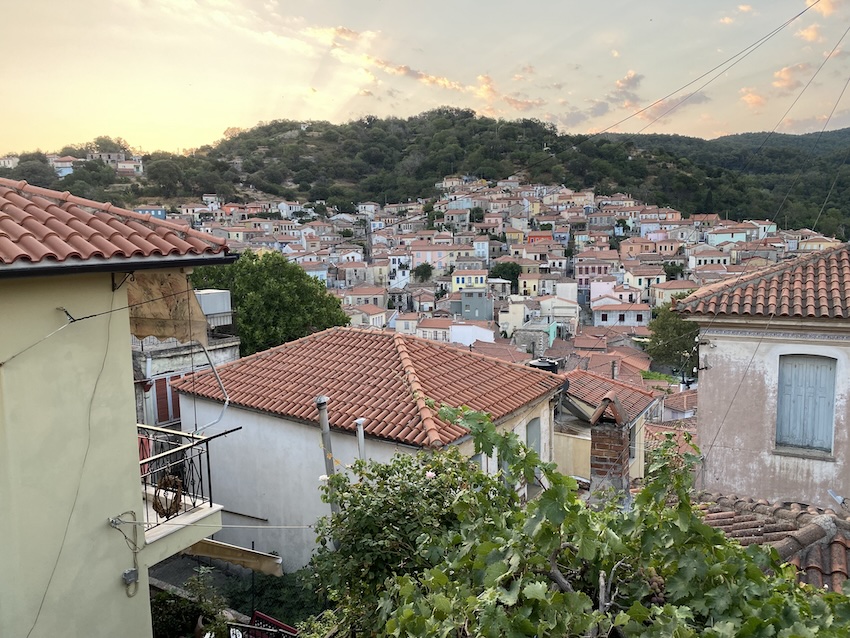
|
|
Aunt Sophia has been up
since six, watering the plants. Andrea calls
her a Mother Teresa type. She is always
so energetic and cheerful and eager to feed
us. She spends much of her time going to
church, though yesterday she went out with
Andrea's Uncle Yannis and picked several bags
of pears before the birds could get to them.
She left some fresh and stewed the rest.
Amarandi loves her and the girls. Whenever we
go anywhere else on the island, as Amarandi
begins to get cranky she says "I want to go
back to my house. I want to see my cousins." I
don't know what they do but I hear her
laughing with the girls for hours upstairs.
There are a million dolls in the house and
Amarandi has adopted all of them.
Just below us is the old
stone road that follows the valley to the city
of Mytilini. On the fifteenth of August, the
day of the celebration of the Virgin Mary, or
Panagia, this road will be full of people who
will have walked from Mytilini and the
villages in between. Agiassos is like Mecca.
If it was not so difficult to leave the island
after the Holy days, we would stay for the
spectacle. Right now all the boats are
arriving full and leaving empty. After the
fifteenth it will be the opposite as the
crowds head back to Athens. By then I will be
sitting at my desk in Carrboro North Carolina,
with the air-conditioner cranked. I don't even
want to think about it. I'd rather be
fighting for space on the ferry. |
|
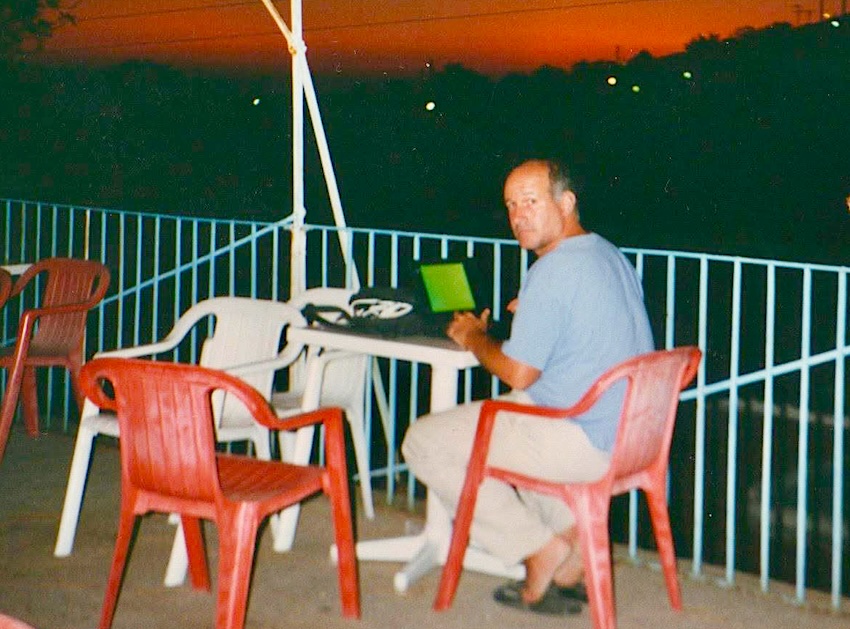
Matt Barrett. Kafeneion Famaka, Agiassis, Lesvos 1996
|
|
Back
to Matt's Agiassos Guide
|
|